Shell Chords
Shell Chords are simply chords without a 5th interval.
Normal Major Chord structure is (1 - 3 - 5).
Removing the 5 results in a diad (2 notes, and not a chord). Shell chords should not be used with simple Major or Minor chords.
Shell Chords need chords with more notes. For example, a seventh chord would work, since it has 4 notes (1 - 3 - 5 - 7).
Take away the 5, and the chord looks like this (1 - 3 - 7).
The Shell Chord Pattern
As stated in the previous paragraph, shell chords simply remove the 5th, since the 5th doesn't add much to the chord's overall sound.
For example, let's make a Shell Chord for C Major Seventh (CMaj7). The notes of CMaj7 are (C - E - G - B)
Remove the 5th, and we are left with C - E - B.
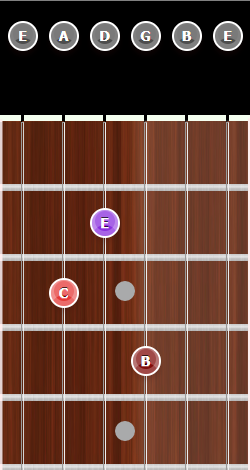
What's So Great About Shell Chords?
One thing that you might already have noticed, is that the notes are in order when you finger them.
The root is fingered using your index finger. The third is fingered with your middle finger, and the 7th with your ring finger.
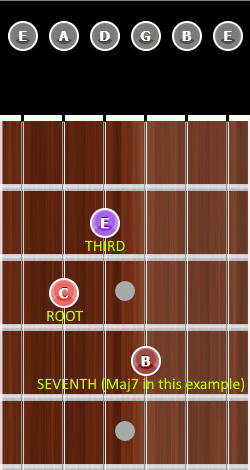
This gives us an easy reference to know which finger to move up or down, in the pattern to create other types of chords.
Sheel Chords Are Moveable
Shell Chords (like most patterns) are moveable up and down the fretboard, as long as the root is on the 5th (A) or 6th (E) string.
To play an DMaj7 Shell Chord, you simply move the pattern up a full step ( 2 frets ). Then is becomes a DMaj7 shell chord.
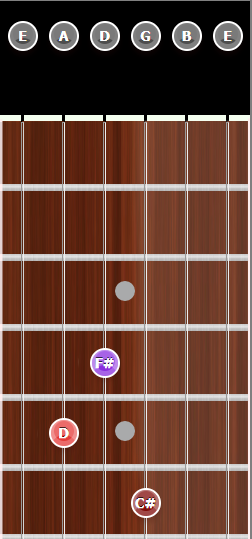
For simplicity, we will stay with the C as the root for the rest of the tutorial, but understand that we can play them anywhere on the neck
as long as the root starts on the A string or the low E string.
Major 7th Pattern (again)
As shown above, the Major 7th Shell pattern is:

So let's move onto more chord types using this pattern as our basic template.
Seventh Chord Pattern
To transform our Major 7th to a Dominant Seventh (Regular 7th), we simply move the Major 7th down a half step.
Since the pattern shows us that the 7th is fingered using our ring finger, we simply drop that one fret.
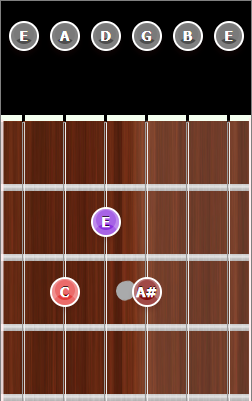
Minor Seventh Pattern
As stated earlier, to make this pattern a Minor chord, we simply move our middle finger down one fret, to flatten the 3rd (1-b4-X-b7).
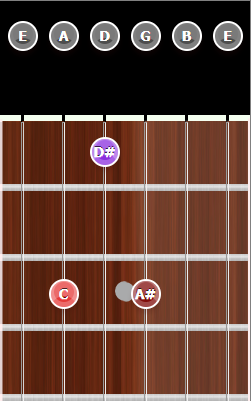
You could use this one pattern, and move around the neck, creating wonderful sounding chords with the root on the A or Low E string.
But Wait!!! There's More. Another Pattern
But there is another pattern. This pattern is not at immediately intuitive as the first pattern, where the root is on the index,
the 3rd is on the middle, and the 7th is on the ring finger.
I sincerely hope that you first master the first pattern BEFOREtrying the second pattern.
The Second Pattern
The Second Shell Chord Pattern only works on the Low E string and involves a string skip.
For a quick refresher, this is out CMaj7 Shell Chord, using pattern one.

In the Second Shell Pattern, we play the root on the Low E string, and take the 3rd from the first pattern and move it up one octave.

This changes the order of the fingering of the notes. The root, in this case C, is played on the 6th string 8th fret using our index finger.
We SKIP THE A STRING COMPLETELY.
The (Maj) 7th is played with our middle finger, on the D string 9th fret.
The 3rd is now played with our ring finger, on the G string, 9th fret.
The same rules apply when changing this pattern to fit a chord. Just move the 7th down one fret for a Dominant (or flattened) 7th, and
move the 3rd down one fret to make the chord a Minor Chord.
But Why 2 Patterns?
The second pattern can be used to keep playing in the same area as the first pattern. For example, say we play a CMaj7 with the root on the A.
This puts our root on the 3rd fret of the A string.
To play a G7 chord after it, we would have to move the pattern up to the 10th fret. Although you could absolutely do that,
you could also play the second pattern on the 3rd fret of the Low E string. This allows you to switch between them without moving positions.

Now, instead of jumping to the 10th fret, we simply use pattern 2, and play the G on the 3rd fret of the lowe E string.
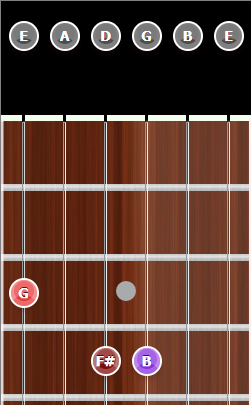
With both patterns, you can use the familiar roots that you normally use with Barre Chords.
Wrap Up
Using Shell Chords can help you learn the fretboard, because you will eventually know all the root notes on the Low E and A strings.
Shell chords are great sounding chords that you can use in writing your songs. You can also use them when playing along with other songs.
They are moveable patterns that you can use to enhance your voicings and playing.